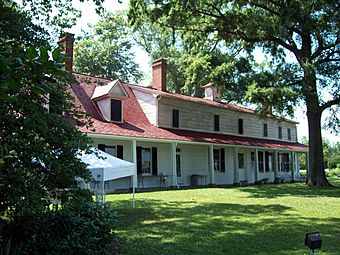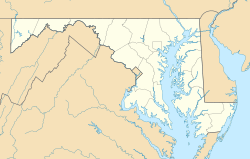Sotterley (Hollywood, Maryland) facts for kids
Quick facts for kids |
|
|
Sotterley Plantation
|
|

Sotterly Plantation, July 2009
|
|
| Location | 44300 Sotterley Lane, Hollywood, Maryland, 20636 |
|---|---|
| Area | 360.8 acres (146.0 ha) |
| Built | 1703 |
| NRHP reference No. | 72001487 |
| Designated NHL | February 16, 2000 |
Sotterley Plantation is a very old and important house located in Hollywood, Maryland. It sits right by the Patuxent River. This historic place is a large, one-and-a-half-story building made of wood. It has wide, flat wooden boards on the outside and a roof made of wood shingles.
Sotterley is special because it still has some very old parts from when it was first built around 1717. It also shows different styles of building from later times. On the property, you can find a cabin where enslaved people were forced to live around 1830. There's also an old brick warehouse from the 1700s and a brick building from the early 1800s used for smoking meat. Other farm buildings include a corn storage building from the early 1800s and many barns from the early 1900s.
Sotterley Plantation opened to the public in 1961. It was once the home of George Plater, who was the sixth Governor of Maryland. Later, it belonged to Herbert L. Satterlee, a lawyer from New York.
This historic site was added to the National Register of Historic Places in 1972. It was recognized as a National Historic Landmark in 2000. This means it's considered very important to the history of the United States.
Visiting Sotterley Plantation
Sotterley Plantation is the only historic plantation in Maryland's Tidewater area that is open for visitors. It offers many activities and educational programs. When you visit, you can explore the main house, which was built in the early 1700s.
- You can see an original cabin where enslaved people lived.
- There's also a customs warehouse and a smokehouse.
- You can walk through a beautiful formal garden.
The property covers about 95 acres of fields, gardens, and riverfront land. It's a great place to learn about history and see how people lived long ago.
Sotterley's Past Residents
Many people lived and worked at Sotterley over the centuries. One person was Julius Clifton Callis, who was the dockmaster for Sotterley Wharf. He was born in 1882. His brothers sometimes helped him at the wharf. After Julius passed away in 1938, his brother Noah became the caretaker of the wharf house.
Laura Virginia Callis, Julius's daughter, went to Sotterley School. A class picture from around 1918 shows her in the second row. The school closed by 1922. These stories help us understand the lives of the people connected to Sotterley.
Images for kids






